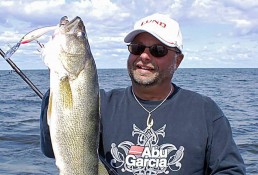The Slowdown Lowdown for Last Open Water
SHARE THIS POST
So much is printed about fishing first ice this time of year that I just had to write about the opposite end of the spectrum. That is, fishing this season’s last open water. This is a great time to fish for walleyes, as anglers have the waterways to themselves. And just like the bite of first ice the few days before a lake freezes, now can be some of the best times for catching. Best of all, the fish are positioned so you can catch them by boat or while wading from shore.
But if you try casting the last open water of the year, you’ll have to totally forgo your memories and techniques from when the water was warmer and employ new tactics. No, the baits and lures won’t change, but how you fish them will. And you’ll need to fish ultra-slow, no matter what.
At a creep
So why fish so slowly?
It all boils down to the basics of freshwater fish biology: this species is cold-blooded and their body temperatures will be the same as the environment in which they swim. This time of year the water can be near freezing, and so too can the bodies of the fish. Perhaps it’s not that fish don’t want to chase down bait, but it’s more that they can’t physically do so.
In perspective, however, is the forage, which is also cold-blooded and cannot skitter away from danger quickly either. Fish a lure or bait too fast in fall and a lot can go wrong in so many ways. Fishing at a creep is a must.
Steady as she goes
One of the first things you may take note of is that artificial lures don’t have much action when fished slowly. In my years of experience fishing open water this time of year, that doesn’t seem to matter. For example, when I cast a size 18 Rapala Original Minnow in shallow water (3 to 7 feet deep) and I reel the lure in so slowly that it literally doesn’t wiggle much at all, the lip just allows it to dive to just a few feet under the surface. It then comes in as steady as a vibrating “stick.”
The size 18 Original Minnow, at 7 inches long, imitates young-of-the-year fish like yellow perch or grown shiners and chubs. Some may say the lure’s too large. But not so this time of the year when forage is truly a full-sized meal.
“If you caught a 7-inch perch, what would you do?” a friend of mine asks, regarding the Rapala Original Minnow, then answering, “You’d throw it back and call it bait.”
But the Minnow needs to be moving to keep it in the strike zone, even though the lure doesn’t need to be reeled in fast to get it to dive. At times, this speed may be too fast if walleyes are lethargic, especially at night. This is when I reach into for a Husky Jerk. These are suspending lures that don’t even have to be moving much to get hit. Again, using the larger-sized 14 at 5 1/2 inches, I’ll cast and reel in a couple feet of line quickly to get the lure to dive a few feet. Then, keeping the line taut, I’ll let the lure sit motionless for several seconds before twitching it. At night, I may let the lure sit still for nearly a minute before giving a jerk.
In fall, even the twitches I give to the lure are subtle. I don’t snap the rod like when I’m bass fishing in spring. Rather, I just lightly twitch the rod tip in about a foot and then reel in the slack.
Are you enjoying this post?
You can be among the first to get the latest info on where to go, what to use and how to use it!
When fishing Rapala Originals or Husky Jerks, I use a 7-foot, medium-action Fenwick spinning rod and a matching Abu Garcia spinning reel spooled with 10-pound-test Berkley FireLine. When suspending lures, this line doesn’t stretch and you can feel every strike, and even know when a swirl and miss has occurred.
Strikes can be very subtle now too. I attach the lure to the line via a small Berkley Cross-Lok snap rather than a snap-swivel, as too much hardware will impede this type of lure’s action.
The standoff
In the days before ice-up, more cold fronts are moving in so it may take a vertical, dead-still presentation with live bait to get walleyes to hit. If this is the case, nothing works better than a live shiner or chub suspended just off the bottom with a slip bobber.
The slip bobber rig is a no-brainer. I tie them up with a size 8 Daiichi Bleeding Bait (Red) Octopus Wide hook with split shot pinched on 16 inches above the hook. This allows the minnow to swim freely and tantalize the walleyes.
On the float end, I use Northland’s largest weighted Lite-Bite Slip Bobber (1 inches) and add just enough split shot so that the line flows freely through the slip bobber, even in ice-cold air temperatures. I also make sure to get the weight just right so that the float just barely stays above the waterline. It may take a little doing, but you’ll want to keep adjusting the weight amounts to ensure there’s enough heaviness so the float stays above the surface, yet is easily pulled under when a bite occurs.
The equipment I prefer for float fishing is a 7 1/2- to 8 1/2-foot spinning rod and matching reel spooled with 8-pound-test Berkley Trilene XL (extra limp). I’ll then connect a 3-foot-long leader of 6-pound-test fluorocarbon line with a Berkley Ball Bearing Swivel. The softness of XL, as well the smaller diameter of the lightweight test, allows the line to flow through the slip bobber easily, even when the air temperature’s below freezing.
Gestalt
Looking to catch walleyes before your favorite lake freezes up? Remember the lowdown on slowing down. Reel in floating body baits at a creep, give a light twitch to suspending body baits and create a standoff with a slip bobber and minnow. All these techniques will work wonders until that last cast, when you hear your lure go “tink” as it bounces off the lake’s surface.
Mark Martin is a professional walleye tournament angler and instructor with the Ice Fishing School/Vacation series. Check out his website at markmartins.net or fishingvacationschool.com for more information.
MWO
SHARE THIS POST
Did you enjoy this post?
You can be among the first to get the latest info on where to go, what to use and how to use it!
Mark Martin
Mark Martin is a professional walleye tournament angler and instructor with the Ice Fishing School/Vacation series. For more information, check out his website at markmartins.net or fishingvacationschool.com.


